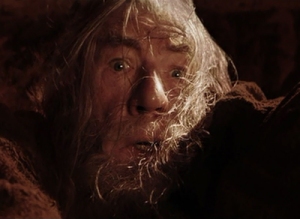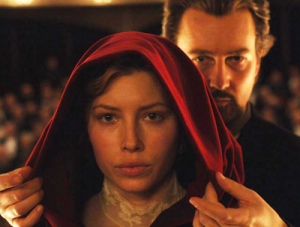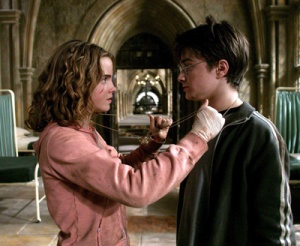When a favourite character dies in a fantasy novel, movie or TV show, our sense of sadness or shock is often tempered by that niggling question that immediately presents itself… are they really dead?
And we can’t be blamed for asking it. Since Lord of the Rings (or perhaps even earlier if you see fairy tales like Snow White as forerunners of the genre) the “they’re-not-really-dead” reveal has been a staple of fantasy. It’s a classic way to dash readers’ hopes and fill them with sadness, then swoop in for an uplifting reveal.
It’s not only fantasy novels and movies that do this – other genres make use of the trope too. However, few do so as extensively as fantasy (excepting perhaps comic books and superhero fiction, in which resurrections became so common people started using the term ‘comic book deaths‘) . The trick comes in many shapes and sizes, so I thought I’d have a look at a few:
Missing, Presumed Dead
 This is perhaps the softest form of the false-death trope, because we never see concrete proof of death and it allows more room for us to doubt. Think of Gandalf in The Lord of the Rings: all the characters presume he is dead because that’s what all the signs indicate… he told them to go on without him, then fell off a precipice with a deadly flaming Balrog. But they didn’t actually see him die. Admittedly, Gandalf’s death was a particularly convincing use of this type of scenario (when I read it I really thought he was dead!), but there have been many less convincing fantasy deaths of this variety.
This is perhaps the softest form of the false-death trope, because we never see concrete proof of death and it allows more room for us to doubt. Think of Gandalf in The Lord of the Rings: all the characters presume he is dead because that’s what all the signs indicate… he told them to go on without him, then fell off a precipice with a deadly flaming Balrog. But they didn’t actually see him die. Admittedly, Gandalf’s death was a particularly convincing use of this type of scenario (when I read it I really thought he was dead!), but there have been many less convincing fantasy deaths of this variety.
Playing Dead
 Sometimes, a character might take a potion, or use some glamour or magic (or just really good acting) to appear dead. It’s the Romeo and Juliet scenario, except usually with a less unhappy ending. I hesitate to give modern examples here, as it’ll be a field of spoilers, but suffice to say I’ve encountered plenty of books, films and TV shows where characters fake death, lie in coffins, or otherwise stage their own demise to trick the villain. Sometimes the audience is in on the ruse, sometimes they are not.
Sometimes, a character might take a potion, or use some glamour or magic (or just really good acting) to appear dead. It’s the Romeo and Juliet scenario, except usually with a less unhappy ending. I hesitate to give modern examples here, as it’ll be a field of spoilers, but suffice to say I’ve encountered plenty of books, films and TV shows where characters fake death, lie in coffins, or otherwise stage their own demise to trick the villain. Sometimes the audience is in on the ruse, sometimes they are not.
The Resurrection
 This type of false-death is rather more convincing, because we usually have the proof of a body and someone confirming the lack of life/pulse. The character is truly dead… but this is fantasy fiction, so anything is possible! Perhaps it’s only a few minutes or hours later, or maybe it’s days or weeks, but our beloved character is resurrected and returned to us, usually by magic of some kind. The classic example that comes to mind is The Lion the Witch and the Wardrobe, when Aslan is murdered and later resurrected by an ancient magic tied to his self-sacrifice. And of course, TV shows like Buffy and Supernatural have regularly resurrected characters.
This type of false-death is rather more convincing, because we usually have the proof of a body and someone confirming the lack of life/pulse. The character is truly dead… but this is fantasy fiction, so anything is possible! Perhaps it’s only a few minutes or hours later, or maybe it’s days or weeks, but our beloved character is resurrected and returned to us, usually by magic of some kind. The classic example that comes to mind is The Lion the Witch and the Wardrobe, when Aslan is murdered and later resurrected by an ancient magic tied to his self-sacrifice. And of course, TV shows like Buffy and Supernatural have regularly resurrected characters.
Living in Another Form
 This is akin to resurrection, though slightly different, in that the character returns to life in a different body, as another creature, or as an undead life form. It’s common in vampire fiction, zombie fiction, and Gothic fantasy in general (shows like Charmed and The Vampire Diaries made regular use of it) but it happens in epic high fantasy too. With Game of Thrones‘s white walkers, I wouldn’t be surprised if we see a little of it there – this article explores a few possibilities for a character resurrection in future Game of Thrones seasons (though if you haven’t seen the latest season and don’t like speculating as to what might happen in future ones, you should avoid reading it).
This is akin to resurrection, though slightly different, in that the character returns to life in a different body, as another creature, or as an undead life form. It’s common in vampire fiction, zombie fiction, and Gothic fantasy in general (shows like Charmed and The Vampire Diaries made regular use of it) but it happens in epic high fantasy too. With Game of Thrones‘s white walkers, I wouldn’t be surprised if we see a little of it there – this article explores a few possibilities for a character resurrection in future Game of Thrones seasons (though if you haven’t seen the latest season and don’t like speculating as to what might happen in future ones, you should avoid reading it).
Time Travel
 Then there is this classic form of – very literally – reversing a death. A key character dies, and other characters have to go back in time to save them. Admittedly, this is usually used in science fiction (Doctor Who, Galaxy Quest) but it’s also occasionally brought into play in fantasy. The most well-known example is probably Harry Potter and the Prisoner of Azkaban, where Hermione, Harry and Ron use the Time Turner to travel back in time and rescue the Hippogriff Buckbeak before it is executed.
Then there is this classic form of – very literally – reversing a death. A key character dies, and other characters have to go back in time to save them. Admittedly, this is usually used in science fiction (Doctor Who, Galaxy Quest) but it’s also occasionally brought into play in fantasy. The most well-known example is probably Harry Potter and the Prisoner of Azkaban, where Hermione, Harry and Ron use the Time Turner to travel back in time and rescue the Hippogriff Buckbeak before it is executed.
________
False deaths can add a lot of drama to a fantasy story, but if used too much they can also drain tension, because we stop fearing the deaths of the characters (e.g. the TV show Supernatural started resurrecting characters so regularly I stopped caring when they died). However, on the whole I believe it’s one of the advantages of the fantasy genre that anything is possible and nothing is unbeatable, even death. It can explore death, life, rebirth and resurrection in interesting ways that a more realistic genre couldn’t.
Above are the 5 kinds of false deaths I regularly come across, but if you’ve encountered another kind that’s not on the list, feel free to mention it in the comments.

What a great post! I never thought of it like this at all! Also I love that you picked Illusionist for fake death- I love that film so much- a similar (but darker) film is the Prestige- and I really recommend it if you haven’t seen it. Resurrection has to be my least favourite false death, followed closely by missing- because those are the ones where I’ve usually already made my peace with it and then they come back. I can’t think of many time travel ones either though- Harry Potter’s a clever one to pick for that
LikeLiked by 1 person
Yes I love the Illusionist. I also love the prestige!! Though it is so dark and grim I’ve been avoiding watching it a second time. That last scene gives me the chills… Such a great film though.
And I do think time travel death reversals are used more commonly in science fiction. Though now that I’m thinking about it, films like Jumanji, The Butterfly Effect and Groundhog Day all have them, and I’d class those as fantasy of a sort. Also in Dickens’s A Christmas Carol there is something akin to a death reversal with the Ghost of Christmas Yet to Come showing Tiny Tim’s death. And I’m sure I could think of some more examples if I thought hard enough!
LikeLiked by 1 person
Me too!! It’s a beautiful movie- I can’t count the number of times I’ve watched it! Agreed- Prestige is so dark- but well worth watching once (I agree it’s not the kind of film you watch over and over- it’s a bit too disturbing for that)
ahh that’s probably why I’m not familiar with it- I’ve started reading some sci fi, but I’m still not up to speed with it. Oh gosh- you’re totally right though- I didn’t even think of those- they’re great examples too (I especially love Jumanji!!) Oh of course, you’re right- that’s so clever! There are loads of egs now you mention them- I never even thought of that before- so clever! 🙂
LikeLike
Then there’s the riskier kill-and-replace, where some sort of doppelganger or changeling assumes the role of the fallen. Villains in soap operas often take the place of a twin, but it is harder because a stranger just doesn’t quite act like the original. They usually are caught sooner or later.
LikeLiked by 1 person
Oh that’s true! A much more sinister kind of false death: the not-quite-the-same doppelgänger replacement. I watched a film once with a very creepy version of this… I’ve forgotten the name of it but an astronaut comes back from a mission in space and only his wife realises he’s not the same person (an alien has taken over his body).
LikeLiked by 1 person
In the movie Soapdish, which is a send-up of soap operas, they have killed off a character many seasons ago … I think it’s Sally Field’s ex-husband. Now, because of political wrangling among the soap’s writers, a decision has been made to bring him back. Problem: He was decapitated in a car accident!
That does not stop them. Through a “cutting-edge new medical procedure,” his head has been sewed on and he is back in business!
LikeLiked by 1 person
Haha, that’s a creative one! Can’t say I’ve ever seen that particular form of resurrection before.
LikeLike